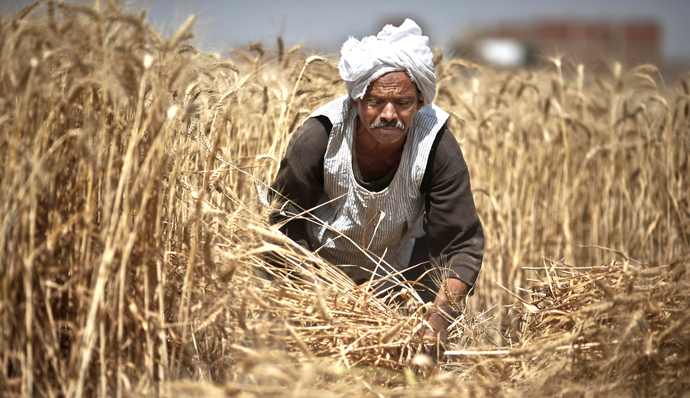Egypt has started following a new strategy of eliminating wheat imports and decreasing import rate in general. The government has adopted a number of procedures and policies in the last few months in order to control imports and eliminate foreign currency attrition. It seems the plan has been successful, as Egyptian import rate has decreased at 22.6 percent, it was estimated at $12b and $838m in the first quarter of 2016 as against $16b and $577m at the same period of 2015. Consequently, import rate spared $3.7m of the costs. Similarly, vegetable crops imports decreased from $648m in March 2015 to $470m at the same period of 2016; it is estimated at 31 percent, according to an official statement by the ministry of commerce and industry.
Moreover, the statement pointed out that Egypt’s imports decrease from global markets including European Union countries in last March 2016 at $5b and $212m as against $5b and $696m at the same month last year; imports decrease of European Union countries is estimated at 8 percent and 40 percent of US imports. It was estimated at $1b and $398m in 2015 and in 2016, the same month; it decreased till $839m.
In addition, Egyptian imports have decreased from Arab countries to $853M as against $1b and $491m at the same month in 2015; imports decrease is estimated at 43 percent. As for African countries, imports decrease rate has been less than the one of Arab countries as it has decreased to $138m in March as against $156m, 12 percent, at the same month of last year.
The government strategy focused on eliminating wheat imports through many steps, it started with building 61 grain-silo and transforming 105 traditional barns to modern ones. This provides a new storage capacity of 4m tons of wheat; cooperating with Bloomberg, the government has made this achievement. The government has built 17 new grain-silos through a grant from UAE. The new grain-silos and modern barns are supposed to increase wheat storage capacity to 1,5m ton and eliminate waste and loss in wheat production process to 25 percent.
A control centre has been built to monitor and control wheat and grain stocks that are stored in the developed barns, receiving wheat in the barns process and sending wheat to mills; as well as creating a network to link the control centre with the grain-silos to monitor the process of local and imported wheat in the grain-silos and barns. Moreover, the centre is responsible for purchasing imported wheat through international stock exchanges to achieve high quality and competitive prices. In addition, receiving local wheat from farmers processes have been going since the receiving price is EGP 420 per ardeb. This new system of importing wheat aims to support farmers directly and stopping local wheat from mixing with imported one that was wasting from EGP 2b to 3b of the country budget.
Ten thousand acres have been opened up in Farafra as a part of the national project to reform and develop 1,5m acres. Egypt has set an agriculture time strategy to reduce wheat import rate; the strategy aims at cultivating half million acres in 3 years’ time. This project will result in providing local wheat and reducing import rate as it will make from 2.5m to 3m tons available yearly. Consequently, import rate will be decreased and local good-quality wheat will be on the local market. Experts assert the contribution of Farafra project to reduce nutritional gap at 25 percent, as it is the right step to achieve wheat self-sufficiency in Egypt.
On the other hand, ministry of agriculture and land reclamation has set a plan based on 20 factors to eliminate wheat crops loss through the processes of harvest, transportation and storing. The plan includes updating the existing cultivation methods, seed selection methods, wheat type selection for each area and measuring cultivated lands; this is significant as wheat poor storage in barns has led to wasting around 500k tons of wheat, in the last few years, on a yearly basis, estimated at EGP 1.5b.
The plan includes using modern technologies in production and cultivation phases, updating mobilization system, providing possible means of transport to move crops from farms to trading centres, marketing, rodent control in barn storages, updating grain-silos, developing mills, producing extra bread and finally increasing penalties for bakeries violating related laws.
A scientific study, done by the Ministry of Agriculture represented by Agriculture Research Centre, has revealed that the total loss of wheat crops through production and trading processes is estimated at 2m tons annually and the total loss in the different processes starting from cultivation to bread production is 609.5k tons. Moreover, the total loss of human consumption and non-human consumption is estimated at 1.3m tons of wheat, equals 13 percent of GDP which equals 9.5m tons, either wheat was used as animal or poultry feed.
Official sources of Agriculture Research Centre have asserted that the average consumption of one Egyptian citizen is 80 percent higher than the European citizen wheat consumption, which is 80kg per person annually. The total wheat amount consumed by animals and poultry is estimated at 670k tons in which 500k tons go to buffalos and 130k tons to cows.
As we believe in the role of media and journalism in helping the country to support economic development, The Middle East Observer proposes the idea of listing modern developed wheat storages and barns projects among small and medium-sized projects list which are offered to youth with facilities; banks could finance youth bids for these projects, and procedures and payment should be facilitated provided that specialized private firms manage such projects. This is to ensure highest levels of production and quality to contribute in Egypt wheat self-sufficiency and then export wheat in the near future.


